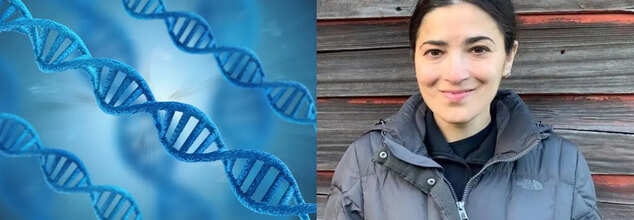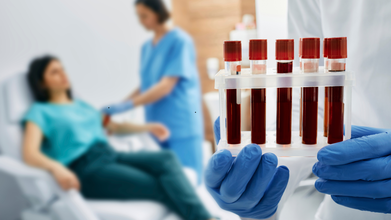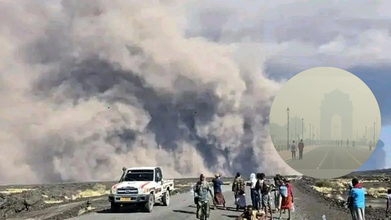- Health Conditions A-Z
- Health & Wellness
- Nutrition
- Fitness
- Health News
- Ayurveda
- Videos
- Medicine A-Z
- Parenting
Living With A Rare Genetic Mutation: Advanced Cystic Fibrosis

Credits: Canva and (R) Emily Kramer-Golinkoff (AP)
Emily Kramer-Golinkoff, 40, today struggles to take in enough oxygen with each breath. She is living with advances cystic fibrosis, which makes simple activities like walking or showering, exhausting for her. She is one of the 40,000 Americans who are affected and are living with the most common fatal genetic disease in the United States.
As per the National Heart, Lung, and Blood Institute, cystic fibrosis is a genetic condition that changes a protein in the body. The faulty protein then affects the body's cells, tissues, and the glands that make mucus and sweat. Cystic fibrosis cause mucus to become thick and sticky. As a result, it builds up and causes blockages, damages, or infections.
While most are born with this condition and continue to be on the medication throughout, for Kramer-Golinoff's rare genetic mutation cannot be managed by the same medication that help about 90% of cystic fibrosis patients.
"For our friends who have been lifting from the sinking ship, we feel such pure joy. But we just feel so eager and desperate to join them. It is really hard to be in this minority of people left behind," Kramer-Golinoff told the Associated Press (AP).
Rare Mutation And Its Challenges
The gap between patients with common and rare mutations is a growing concern. Advances in genetic science have uncovered the precise causes behind many brutal diseases, offering treatments to some but not all. Patients with rare mutations often face fewer treatment options and a much grimmer outlook.
Market forces contribute to the problem. Drug companies tend to focus on treatments that serve the largest groups of patients. “You need a sufficiently large number of patients in a major market in order for a company to be interested in going forward,” said Dr. Kiran Musunuru, a gene editing expert at the University of Pennsylvania. He described this reality as "mutational discrimination."
Charities, including Emily’s Entourage—a nonprofit co-founded by Kramer-Golinkoff—are working to change this. Their fundraising efforts have helped jump-start gene therapy research that could benefit patients with any mutation. Although these treatments are likely years away, "just to have these therapies in trials provides so much hope," she told the AP.
To Live With Cystic Fibrosis
Kramer-Golinoff was diagnosed with this condition at just six weeks old. “As I’ve gotten older … my CF has gotten worse, despite all my best efforts to delay it,” she shared with the AP. Before her condition worsened, she earned a master’s degree in bioethics from the University of Pennsylvania, traveled, worked, and spent time with friends. But over time, she developed CF-related diabetes and other complications, including frequent infections. Since the pandemic began, she has lived in isolation with her parents in Greater Philadelphia. “CF is a real monster of a disease,” she said.
Meanwhile, newer therapies known as CFTR modulators have dramatically improved life for many cystic fibrosis patients. However, these drugs don't work for those with rare or unknown mutations, often leaving people from underrepresented groups, including Black patients, at a disadvantage.
A Ray Of Hope
One promising solution is developing "mutation agnostic" gene therapies that would work for all patients, regardless of the specific genetic mutation. “There’s a huge push to develop these therapies," said Dr. Garry Cutting of the Johns Hopkins Cystic Fibrosis Center, as reported by AP.
The Cystic Fibrosis Foundation reports that 14 experimental gene therapies are currently in development. Many aim to deliver a healthy copy of the CFTR gene to patients' cells, enabling proper protein function.
Spirovant Sciences, a company partly funded by Emily’s Entourage, is sponsoring one such therapy. The first patient received it in a 53-week clinical trial at Columbia University last November.
Despite her worsening condition—living with 30% lung function, kidney issues, and pulmonary hypertension—Kramer-Golinkoff remains hopeful. “You have to make really conscientious choices … throughout the day on how to use your limited energy,” she told the AP. “We’re incredibly excited about the promise of gene therapies. They can’t come soon enough.”
5 Tests Your GP Isn’t Ordering, But Could Spot A Disease Even Before Symptoms Appear, According to Doctor

Credits: Canva
It is not hidden that India indeed is the diabetes capital of the world. As per the World Health Organization (WHO), at least 77 million people in the country are living with diabetes, and 25 million of them are prediabetic. Not only that, but there has been an increase in chronic conditions in India too, all thanks to the lifestyle. In fact, as per the Indian Council of Medical Research, 56.4% of the total disease burden in India comes from unhealthy diets. This has led to cardiovascular diseases, cancers, respiratory diseases, and high cholesterol.
So, how can someone stay a step ahead of all that? Dr Brijmohan Arora, a senior diabetologist from Delhi suggested 5 biomarkers that can help you stay a step ahead of the chronic diseases. These tests can help you live a longer and healthier life.
“Most doctors still rely on superficial tests, but in 2025 we have far more powerful biomarkers to predict your future health,” says Dr Arora. The doctor explains that basic tests like a standard lipid or cholesterol panel only give a surface level picture, however, advanced biomarkers dig deeper and can help in catching risks earlier and reveal what is happening inside your blood vessels and metabolism even before the disease shows up.
The Five Biomarkers To Keep You Healthy
ApoB
“ApoB is like a bullet that enters your arteries, it’s the most advanced and accurate form of cholesterol testing," the doctor says.
What ApoB means:
- ApoB (Apolipoprotein-B) counts the actual number of harmful cholesterol-carrying particles in your blood.
- These particles directly drive plaque formation.
- It is more predictive of heart attack risk than LDL alone.
Why it matters:
Two people with the same LDL cholesterol can have very different ApoB levels. The one with higher ApoB is at higher risk. The doctor calls it the "single most accurate marker of heart-attack risk".
HS-CRP
“High-sensitivity CRP and homocysteine are inflammation markers, they help predict inflammation of the heart and blood vessels,” he says.
What hs-CRP means:
- A highly sensitive test that detects tiny amounts of inflammation, especially in arteries.
- Elevated hs-CRP is linked to heart attacks, stroke, plaque instability, and chronic disease.
What Homocysteine means:
An amino acid that, when elevated, increases risk of blood clots, heart attacks, and cognitive decline.
Often linked to vitamin B12 or folate deficiency.
Why they matter:
They don’t diagnose disease… they predict risk, which makes them powerful preventive markers.
Homocysteine
It is an amino acid that is naturally found in the blood that can be harmful to the lining of the artery walls when levels are high. Its levels are influenced by factors like vitamin deficiencies (especially B12, B6, and folate), genetics, and kidney disease. Dr Arora notes that high levels of this could mean higher risk of stroke, dementia, and clotting diseases.
Fasting Insulin
“Fasting insulin gives us a window into the future, it picks up abnormalities long before sugar levels rise.”
What Fasting Insulin means:
- Measures how hard your pancreas is working to keep your sugar normal.
- High fasting insulin = early insulin resistance.
Why it matters:
You can have completely normal glucose and HbA1c, yet be on the path to prediabetes, diabetes, obesity, fatty liver, and PCOS years in advance.
This test detects problems before they appear on regular reports.
Omega-3 Index
“Omega-3 Index gives deep insight into your metabolic health and risk of conditions like Alzheimer’s.”
What Omega-3 Index means:
Measures the percentage of omega-3 fatty acids in your red blood cells.
Higher levels are linked to:
- Better metabolic health
- Lower inflammation
- Heart protection
- Improved brain function
- Lower dementia risk
Why it matters:
Few labs offer it, but it’s one of the strongest markers of long-term inflammation and cell health.
Volcanic Ash From Ethiopia Is Drifting Toward India, Should Delhi Be Worried?

Credits: AP, ANI
For the first time in 12,000 years, the Ethiopian Hayli Gubbi volcano has erupted. The volcanic plumes has already traveled thousands of kilometer to India and has reached altitudes between 25,000 and 45,000 feet. It has affected Delhi-NCR, Gujarat, Punjab, and Rajasthan, and several other parts of North India. As per the reports, the speed at which the plumes are travelling is at nearly 100 to 120 km/hour at altitudes above 10 km. The plumes contains volcanic ash, sulphur dioxide, and small particles of glass and rock.
Amid Delhi's continuously worsening air pollution, the question rises whether the plumes and the chemicals it contains will impact Delhi's air and the air quality.
Can The Ethiopian Volcanic Plumes Impact Delhi?
The volcanic plumes reached Delhi around 11pm, confirmed the India Meteorological Department (IMD). As per News 18, some residents noticed an unusually diffused, cloud-like haze. However, IMD Director General M Mohapatra said that any significant deterioration in Delhi's air quality is unlikely.
Mohapatra explained that the ash is circulating at high altitudes, which is well above where Delhi's pollution typically concentrates. “It is unclear whether it will impact air quality, but any significant impact is unlikely as it is at higher levels," because plume is in the "upper levels". The Director General noted that there will only be a "marginal rise in temperature" as the ash could behave like cloud cover and absorb and re-radiate heat. However, in terms of Delhi's air quality, he noted that any influence near the ground would be "marginal".
However, the volcanic plumes have impacted flight operations in and around the Indian airspace. Airlines cancelled flights, with IndiGo grounding six flights. Akasa Air said its flights to and from Jedda, Kuwait, and Abu Dhabi scheduled for today and November 24 have been cancelled. KLM Royal Dutch Airplines too cancelled its Amsterdam-Delhi and return flights. IndiGo on X said, "Following the recent eruption of the #HayliGubbi volcano in #Ethiopia, ash clouds are reported to be drifting towards parts of western India. We understand that such news may cause concern, and we want to reassure you that your safety remains our highest priority".
The plumes are expected to head towards China next. It is expected to leave India by 14:00 GMT (7:30 pm local time) on Tuesday.
Can Volcanic Eruption Impact Health Of Those Who Live Near It?
As per the Centers for Disease Control and Prevention (CDC), volcanoes are geographical formations where lava, small rocks, and steam are released onto the surface of the earth.
When a volcano erupts, it can release harmful particles, including volcanic gases and ash, into the air. These volcanic gases may have an adverse impact on your health, including:
- Carbon Dioxide (CO2)
- Sulfur Dioxide (So2)
- Hydrogen Chloride (HCL)
- Hydrogen Sulfide (H2s)
- Radon (Rn)
- Hydrogen Fluoride (HF)
- Sulfuric Acid (H2SO4)
How Each Toxic Gas Impacts Health
Carbon Dioxide
As per the USDA Food and Safety Inspection Service, CO2 is colorless, odorless, non-flammable gas that naturally occurs in the atmosphere. As the CDC mentions, it is also released when a volcanic eruption takes place. CO2 is considered to be minimally toxic by inhalation. The primary health effects caused by CO2 are the result of its behavior as a simple asphyxiant.
A simple asphyxiant is a gas which reduces or displaces the normal oxygen in breathing air.
Symptoms of mild CO2 exposure may include headache and drowsiness. At higher levels, rapid breathing, confusion, increased cardiac output, elevated blood pressure, and increased arrhythmias may occur. Breathing oxygen-depleted air caused by extreme CO2 concentrations can lead to death by suffocation.
Sulfur Dioxide
As per the National Park Service, Sulfur dioxide is a colorless, reactive air pollutant with a strong odor. This gas can be a threat to human, animal and plant health.
It can irritate the skin and mucous membranes of the eyes, nose, throat, and lungs. High concentrations of SO2 can also cause inflammation and irritation of the respiratory system. This can then lead to pain when taking deep breaths, coughing, throat irritation and breathing difficulties. This gas can further affect lung function, worsen asthma attacks, and exacerbate existing heart diseases.
Hydrogen Chloride
As per the CDC, hydrogen chloride is a colorless to slightly yellow gas with a pungent odor. On exposure to air, the gas forms dense white vapors due to condensation with atmospheric moisture.
Upon inhalation, the odor could irritate and affect the lungs. While it cannot be absorbed through the skin, its direct contact could irritate the skin and cause chemical burns. The ingestion could also lead to corrosive injury to the lips, mouth, throat, esophagus, and stomach.
Hydrogen Sulfide
As per the US Department of Labor, hydrogen sulfide causes a wide range of health effects, especially if you breathe it and are exposed to it for a longer duration. Its exposure to very high concentrations could also lead to death.
It is a highly flammable, explosive gas, and can cause a life-threatening situation when not handled properly. Its exposure to skin can cause "blue skin" or frostbite.
Radon
As per the US Environmental Protection Agency, radon could lead to lung cancer. It is also the number one cause of lung cancer among non-smokers.
Hydrogen Fluoride
As per the CDC, it is also a colorless gas or liquid that could cause severe damage to the body. The effects could also depend on how long one is exposed to the gas. If it is breathed in, it can irritate the eyes and respiratory tract. Breathing in a large amount could cause death from irregular heartbeat or from fluid buildup in the lungs. It can also cause rash and deep, slow-healing burns.
Sulfuric Acid
As per the Department of Climate Change, Energy, the Environment and Water run by the Australian Government, sulfuric acid is the world's largest volume industrial chemical. It is corrosive in nature and can severely burn the skin and eyes. It can also cause third-degree burns and blindness on contact. It can also irritate the eyes, nose, throat, and lungs.
UK Health Experts Issue Antibiotics Alert For Cold and Flu; Here’s Why

Credits: Canva
Health authorities in the United Kingdom have released a fresh advisory on the use of antibiotics this winter. The UK Health Security Agency (UKHSA) reminded the public that these medicines are designed for specific types of illness and are not useful in every situation.
Antibiotics treat or prevent bacterial infections by killing the bacteria outright or limiting their ability to grow. This allows the body’s own immune defences to clear the remaining infection. What they cannot do is treat illnesses caused by viruses.
This includes common winter infections such as colds, flu, and COVID-19. In a post on X, the UKHSA said, “Antibiotics don't work for colds and flu. Pharmacists can guide you on managing your symptoms.”
Health Officials Issue Winter Antibiotics Warning
The agency also urged people to keep a few basic points in mind when using antibiotics:
- Do not use them for colds or flu
- Do not keep unfinished courses for future use
- Always take them according to instructions
Flu And Cold: Why The Warning Matters
The reminder follows the release of the UKHSA’s English Surveillance Programme for Antimicrobial Utilisation and Resistance (ESPAUR) report, which shows that nearly 400 people in England each week are now diagnosed with infections that no longer respond well to antibiotics. These resistant infections are harder to treat and pose a greater risk of complications.
Experts believe that years of unnecessary or incorrect use of antibiotics have contributed to a decline in their effectiveness. This widespread overuse has also encouraged the rise of “superbugs”, a term used for bacteria that can withstand several commonly used antibiotics. Examples highlighted by the NHS include:
- MRSA (methicillin-resistant Staphylococcus aureus)
- Clostridium difficile (C. diff)
- The bacteria responsible for multi-drug-resistant tuberculosis
The NHS notes that these infections can be severe, difficult to control, and are becoming a growing cause of illness and death worldwide. The larger concern is that entirely new bacteria may emerge with resistance to every antibiotic currently available.
Cold Symptoms
A cold usually develops slowly and tends to be milder. Typical signs include a runny or blocked nose, sneezing, a sore throat, mild cough, slight body ache, and low fever if any. Many people also feel pressure around the sinuses and a mild headache.
Flu Symptoms
Flu sets in quickly and is generally more intense. People often experience a high fever, chills, deep muscle pain, marked fatigue, headache, dry cough, sore throat, and a sudden drop in energy. Some may also have nausea, loss of appetite, or chest discomfort.
What Experts Are Saying
Dr Alicia Demirjian, consultant epidemiologist and clinical lead for antimicrobial resistance and prescribing at the UKHSA, said, “Antibiotic resistance is one of the biggest threats facing modern medicine, but the good news is we can all do something about it.”
If a doctor has prescribed antibiotics, it is vital to take the medicine exactly as told, without skipping or delaying doses.
The NHS advises, “If you miss a dose, check the patient information leaflet to see what to do. If you are unsure, speak with a pharmacist or your GP. In many cases, you can take the missed tablet as soon as you remember and then continue the course as usual. If it is almost time for your next dose, leave out the missed one and return to your usual schedule.”
© 2024 Bennett, Coleman & Company Limited

